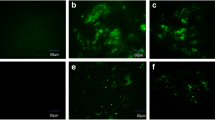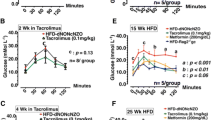Abstract
Purpose
The latest treatments do not sufficiently prevent miscarriage and fetal growth restriction (FGR) in pregnant women. Here, we assessed the effects of a human protein, CTRP6, that specifically inhibits the activation of the alternative complement pathway on miscarriage, fetal and placental development.
Methods
Pregnant CBA/J mice mated with DBA/2 male mice as a model of spontaneous abortion and FGR were randomly divided into the control and CTRP6 groups. In the CTRP6 group, the mice were intravenously administered CTRP6 on days 4.5 and 6.5 post-conception (dpc). The abortion rate and fetal and placental weights on 14.5 dpc were examined. Remodeling of the spiral artery was also assessed.
Results
The abortion rate in the CTRP6 group (13%) was reduced compared to the control group (21%), but there was no statistical difference. The placental and fetal weights in the CTRP6 group were also heavier than those in the control (P < 0.05). Moreover, the thickness of the blood vessel wall in the CTRP6 group was significantly thinner than that in the control (P < 0.05) and comparable to that in the non-abortion model (CBA/J x BALB). The ratio of the inner-per-the-outer diameter of the spiral artery increased more in the CTRP6 group than that in the control (P < 0.05). As well, the Th1/Th2 cytokine ratio was significantly reduced by CTRP6 treatment.
Conclusions
Taken together, the supplementation with a protein that regulates the alternative complement pathway in vivo improves FGR and promotes spiral artery remodeling in a mouse model of miscarriage and FGR.






Similar content being viewed by others
References
Sugiura-Ogasawara M, Ozaki Y, Katano K, Suzumori N, Kitaori T, Mizutani E. Abnormal embryonic karyotype is the most frequent cause of recurrent miscarriage. Hum Reprod. 2012;27:2297–303.
Munné S, Kaplan B, Frattarelli JL, Child T, Nakhuda G, Shamma FN, Silverberg K, Kalista T, Handyside AH, Katz-Jaffe M, Wells D, Gordon T, Stock-Myer S, Willman S, STAR Study Group. Preimplantation genetic testing for aneuploidy versus morphology as selection criteria for single frozen-thawed embryo transfer in good-prognosis patients: a multicenter randomized clinical trial. Fertil Steril. 2019;112:1071–9.
Sato T, Sugiura-Ogasawara M, Ozawa F, Yamamoto T, Kato T, Kurahashi H, Kuroda T, Aoyama N, Kato K, Kobayashi R, Fukuda A, Utsunomiya T, Kuwahara A, Saito H, Takeshita T, Irahara M. Preimplantation genetic testing for aneuploidy: a comparison of live birth rates in patients with recurrent pregnancy loss due to embryonic aneuploidy or recurrent implantation failure. Hum Reprod. 2019;34:2340–428.
Le Bouteiller P, Bensussan A. Up-and-down immunity of pregnancy in humans. F1000Res. 2017;6:1216.
Kovats S, Main EK, Librach C, Stubblebine M, Fisher SJ, DeMars R. A class I antigen, HLA-G, expressed in human trophoblasts. Science. 1990;248:220–3.
Munn DH, Zhou M, Attwood JT, Bondarev I, Conway SJ, Marshall B, Brown C, Mellor AL. Prevention of allogeneic fetal rejection by tryptophan catabolism. Science. 1998;281:1191–3.
Trowsdale J, Betz AG. Mother’s little helpers: mechanisms of maternal-fetal tolerance. Nat Immunol. 2006;7:241–6.
Moffett A, Colucci F. Uterine NK-cells: active regulators at the maternal-fetal interface. J Clin Invest. 2014;124:1872–9.
El Costa H, Tabiasco J, Berrebi A, Parant O, Aguerre-Girr M, Piccinni MP, Le Bouteiller P. Effector functions of human decidual NK cells in healthy early pregnancy are dependent on the specific engagement of natural cytotoxicity receptors. J Reprod Immunol. 2009;82:142–7.
Yang F, Zheng Q, Jin L. Dynamic function and composition changes of immune cells during normal and pathological pregnancy at the maternal-fetal interface. Front Immunol. 2019;10:2317.
Wang W, Sung N, Gilman-Sachs A, Kwak-Kim J. T Helper (Th) Cell profiles in pregnancy and recurrent pregnancy losses: Th1/Th2/Th9/Th17/Th22/Tfh cells. Front Immunol. 2020;11:2025.
Lin Y, Ren L, Wang W, Di J, Zeng S, Saito S. Effect of TLR3 and TLR7 activation in uterine NK cells from non-obese diabetic (NOD) mice. J Reprod Immunol. 2009;82:12–3.
Girardi G, Yarilin D, Thurman JM, Holers VM, Salmon JE. Complement activation induces dysregulation of angiogenic factors and causes fetal rejection and growth restriction. J Exp Med. 2006;203:2165–75.
Goldman AS, Prabhakar BS. The complement system. in: Baron’s Medical Microbiology (Baron S et al, eds.) (4th ed. ed.). Univ of Texas Medical Branch. 1996
Girardi G, Prohászka Z, Bulla R, Tedesco F, Scherjon S. Complement activation in animal and human pregnancies as a model for immunological recognition. Mol Immunol. 2011;48:1621–30.
van de Geijn FE, Dolhain RJ, van Rijs W, Hazes JM, de Groot CJ. Mannose-binding lectin genotypes and pre-eclampsia: a case-control study. Hum Immunol. 2007;68:888–93.
Than NG, Romero R, Erez O, Kusanovic JP, Tarca AL, Edwin SS, Kim JS, Hassan SS, Espinoza J, Mittal P, Mazaki-Tovi S, Friel L, Gotsch F, Vaisbuch E, Camacho N, Papp Z. A role for mannose-binding lectin, a component of the innate immune system in pre-eclampsia. Am J Reprod Immunol. 2008;60:333–45.
Vianna P, Da Silva GK, Dos Santos BP, Bauer ME, Dalmáz CA, Bandinelli E, Chies JA. Association between mannose-binding lectin gene polymorphisms and pre-eclampsia in Brazilian women. Am J Reprod Immunol. 2010;64:359–74.
Glotov AS, Tiys ES, Vashukova ES, Pakin VS, Demenkov PS, Saik OV, Ivanisenko TV, Arzhanova ON, Mozgovaya EV, Zainulina MS, Kolchanov NA, Baranov VS, Ivanisenko VA. Molecular association of pathogenetic contributors to pre-eclampsia (pre-eclampsia associome). BMC Syst Biol. 2015;9:S4.
Wu W, Yang H, Feng Y, Zhang P, Li S, Wang X, Peng T, Wang F, Xie B, Guo P, Li M, Wang Y, Zhao N, Wang D, Wang S, Zhang Y. Polymorphisms in complement genes and risk of preeclampsia in Taiyuan. China Inflamm Res. 2016;65:837–45.
Poveda NE, Garcés MF, Ruiz-Linares CE, Varón D, Valderrama S, Sanchez E, Castiblanco-Cortes A, Agudelo-Zapata Y, Sandoval-Alzate HF, Leal LG, Ángel-Müller E, Ruíz-Parra AI, González-Clavijo AM, Diéguez C, Nogueiras R, Caminos JE. Serum adipsin levels throughout normal pregnancy and preeclampsia. Sci Rep. 2016;6:20073.
Wong GW, Krawczyk SA, Kitidis-Mitrokostas C, Revett T, Gimeno R, Lodish HF. Molecular, biochemical and functional characterizations of C1q/TNF family members: adipose-tissue-selective expression patterns, regulation by PPAR-gamma agonist, cysteine-mediated oligomerizations, combinatorial associations and metabolic functions. Biochem J. 2008;416:161–77.
Murayama MA, Kakuta S, Inoue A, Umeda N, Yonezawa T, Maruhashi T, Tateishi K, Ishigame H, Yabe R, Ikeda S, Seno A, Chi HH, Hashiguchi Y, Kurata R, Tada T, Kubo S, Sato N, Liu Y, Hattori M, Saijo S, Matsushita M, Fujita T, Sumida T, Iwakura Y. CTRP6 is an endogenous complement regulator that can effectively treat induced arthritis. Nat Commun. 2015;6:8483.
Sadeghi A, Fadaei R, Moradi N, Fouani FZ, Roozbehkia M, Zandieh Z, Ansaripour S, Vatannejad A, Doustimotlagh AH. Circulating levels of C1q/TNF-α-related protein 6 (CTRP6) in polycystic ovary syndrome. IUBMB Life. 2020;72:1449–59.
Tuteja G, Cheng E, Papadakis H, Bejerano G. A comprehensive database of SNPs studied in association with pre-eclampsia. Placenta. 2012;33:1055–7.
Clark DA, Chaouat G, Arck PC, Mittruecker HW, Levy GA. Cytokine-dependent abortion in CBA × DBA/2 mice is mediated by the procoagulant fgl2 prothrombinase [correction of prothombinase]. J Immunol. 1998;160:545–9.
Girardi G. Guilty as charged: all available evidence implicates complement’s role in fetal demise. Am J Reprod Immunol. 2008;59:183–92.
McKelvey K, Yenson V, Ashton A, Morris JM, McCracken SA. Embryonic/fetal mortality and intrauterine growth restriction is not exclusive to the CBA/J sub-strain in the CBA × DBA model. Sci Rep. 2016;6:35138.
Takeshita A, Kusakabe KT, Hiyama M, Kuniyoshi N, Kondo T, Kano K, Kiso Y, Okada T. Dynamics and reproductive effects of complement factors in the spontaneous abortion model of CBA/J×DBA/2 mice. Immunobiology. 2014;219:385–91.
Schumacher A, Sharkey DJ, Robertson SA, Zenclussen AC. Immune cells at the fetomaternal interface: how the microenvironment modulates immune cells to hoster fetal development. J Immunol. 2018;201:325–34.
Fraser R, Whitley GS, Johnstone AP, Host AJ, Sebire NJ, Thilaganathan B, Cartwright JE. Impaired decidual natural killer cell regulation of vascular remodelling in early human pregnancies with high uterine artery resistance. J Pathol. 2012;228:322–32.
Charalambous F, Elia A, Georgiades P. Decidual spiral artery remodeling during early post-implantation period in mice: investigation of associations with decidual uNK cells and invasive trophoblast. Biochem Biophys Res Commun. 2012;417:847–52.
Staff AC. The two-stage placental model of preeclampsia: an update. J Reprod Immunol. 2019;134–5:1–10.
Rana S, Lemoine E, Granger JP, Karumanchi SA. Preeclampsia: pathophysiology, challenges, and perspectives. Circ Res. 2019;124:1094–112.
Sugiura-Ogasawara M, Nozawa K, Nakanishi T, Hattori Y, Ozaki Y. Complement as a predictor of further miscarriage in couples with recurrent miscarriages. Hum Reprod. 2006;21:2711–4.
Xu C, Mao D, Holers VM, Palanca B, Cheng AM, Molina H. A critical role for murine complement regulator crry in fetomaternal tolerance. Science. 2000;287:498–501.
Cunningham DS, Tichenor JR. Decay-accelerating factor protects human trophoblast from complement-mediated attack. Clin Immunol Immunopathol. 1995;74:156–61.
Girardi G. Complement activation, a threat to pregnancy. Semin Immunopathol. 2018;40:103–11.
Brooks JP, Radojicic C, Riedl MA, Newcomer SD, Banerji A, Hsu FI. Experience with intravenous plasma-derived C1-inhibitor in pregnant women with hereditary angioedema: a systematic literature review. J Allergy Clin Immunol Pract. 2020;8:1875–80.
Sarno L, Tufano A, Maruotti GM, Martinelli P, Balletta MM, Russo D. Eculizumab in pregnancy: a narrative overview. J Nephrol. 2019;32:17–25.
Höchsmann B, Murakami Y, Osato M, Knaus A, Kawamoto M, Inoue N, Hirata T, Murata S, Anliker M, Eggermann T, Jäger M, Floettmann R, Höllein A, Murase S, Ueda Y, Nishimura JI, Kanakura Y, Kohara N, Schrezenmeier H, Krawitz PM, Kinoshita T. Complement and inflammasome overactivation mediates paroxysmal nocturnal hemoglobinuria with autoinflammation. J Clin Invest. 2019;129:5123–36.
Redman CW, Sargent IL. Latest advances in understanding preeclampsia. Science. 2005;308:1592–4.
Nakagawa K, Kwak-Kim J, Kuroda K, Sugiyama R, Yamaguchi K. Immunosuppressive treatment using tacrolimus promotes pregnancy outcome in infertile women with repeated implantation failures. Am J Reprod Immunol. 2017 Sep;78(3):e12682.
Nakagawa K, Kwan-Kim J, Ota K, Kuroda K, Hisano M, Sugiyama R, Yamaguchi K. Immunosuppression with tacrolimus improved reproductive outcome of women with repeated implantation failure and elevated peripheral blood TH1/TH2 cell ratios. Am J Reprod Immunol. 2015;7:353–61.
Acknowledgements
The authors thank Dr. Brian Nolan for editing a draft of this manuscript.
Funding
Part of this work was supported by grants from the Japan Society for the Promotion of Science (KAKENHI 18H06257 and 19K18649 to AT, and 20K09674 to SH). Histological experiments and ELISA were performed in Research Support Platform of Osaka City University Graduate School of Medicine.
Author information
Authors and Affiliations
Contributions
MK, AT, and SH designed the experiment, interpreted the results, and wrote the manuscript with the help from all authors. MK, YM, and DT supervised the project.
Corresponding author
Ethics declarations
Conflict of interest
The authors declare no competing interests.
Additional information
Publisher's note
Springer Nature remains neutral with regard to jurisdictional claims in published maps and institutional affiliations.
Supplementary Information
Below is the link to the electronic supplementary material.
Rights and permissions
Springer Nature or its licensor holds exclusive rights to this article under a publishing agreement with the author(s) or other rightsholder(s); author self-archiving of the accepted manuscript version of this article is solely governed by the terms of such publishing agreement and applicable law.
About this article
Cite this article
Kurokawa, M., Takeshita, A., Hashimoto, S. et al. Prevention of intrauterine fetal growth restriction by administrating C1q/TNF-related protein 6, a specific inhibitor of the alternative complement pathway. J Assist Reprod Genet 39, 2191–2199 (2022). https://doi.org/10.1007/s10815-022-02582-1
Received:
Accepted:
Published:
Issue Date:
DOI: https://doi.org/10.1007/s10815-022-02582-1




